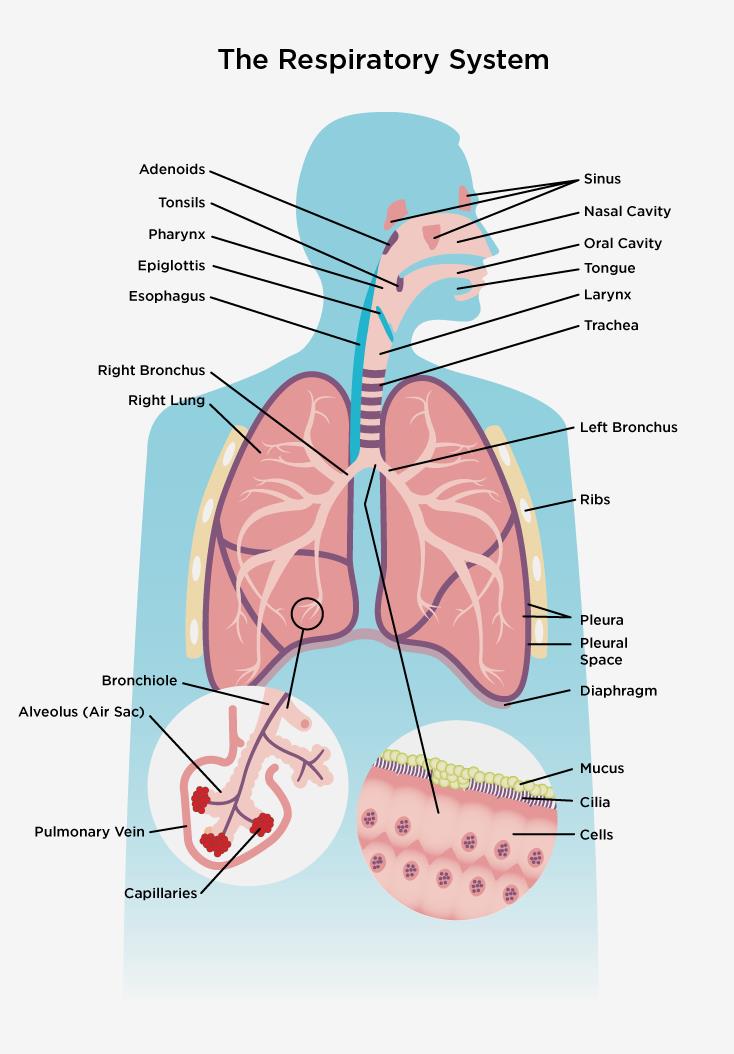This is how the AI article summary could look. Lorem ipsum dolor sit amet, consectetur adipiscing elit, sed do eiusmod tempor incididunt ut labore et dolore magna aliqua. Ut enim ad minim veniam, quis nostrud exercitation ullamco laboris nisi ut aliquip ex ea commodo consequat.
Basic lung anatomy
The lungs are vital organs in the chest that are part of the respiratory system which facilitates breathing.
Here’s a summary of the anatomy of the respiratory system.
Main Components of Respiratory System
- Trachea (Windpipe): divides into two primary bronchi, one for each lung.
- Bronchi: airways that branch into smaller bronchioles.
- Bronchioles: lead to alveoli, where gas exchange occurs.
- Lungs: primary organs for breathing, located on either side of the heart; dense spongy tissue comprised of
- Alveoli: tiny air sacs where oxygen diffuses into blood and carbon dioxide is removed. About 240 million in each lung (compare to 1 million glomeruli in each kidney)
- Hilum: where the bronchus and pulmonary artery and vein enter the lung
- Pleura: a double-layered membrane surrounding each lung, reducing friction during breathing.
- Diaphragm: A large muscle located below the lungs that separates the chest from the abdomen and helps with breathing.
- Ribcage: The bony structure surrounding and protecting the lungs.
Lung Structure
- Cone shaped organs
- Right Lung: divided into three lobes (upper, middle, lower); shorter to allow for liver below. Is it bigger and heavier than the left (see below)
- Left Lung: divided into two lobes (upper, lower); narrower to allow for the heart.
Upper and Lower Lobes
 Lateral chest x-ray of R lung
Lateral chest x-ray of R lung
Note. Most of the posterior (back) of the lung is the the lower lobe, and most of the anterior (front) is the upper lobe.
Blood Supply
- Pulmonary Arteries: carry deoxygenated blood from the heart to the lungs.
- Pulmonary Veins: carry oxygenated blood from the lungs to the heart.
Weight of Lungs
- The total weight of both lungs in an adult is approximately 1.4 kilograms, with the right lung generally heavier than the left
- Individual lung weights vary, but a healthy right lung can weigh around 660g and a left lung around 580g for males
- Whilst female lungs are typically lighter
- Lung weight is not significantly correlated with body weight or BMI.
How They Work Together
- Air Intake: When you inhale, air enters through your airways.
- Gas Exchange: Air travels to the lungs’ air sacs (alveoli), where oxygen moves into the blood and carbon dioxide is released from the blood.
- Blood Supply: The heart and blood vessels work with the lungs to carry oxygen and carbon dioxide to and from the tissues and organs.
Interesting Lung Facts
- An average person breathes in (and out) around 11,000 litres of air every day.
This summary provides a concise overview of lung anatomy.

 Lateral chest x-ray of R lung
Lateral chest x-ray of R lung